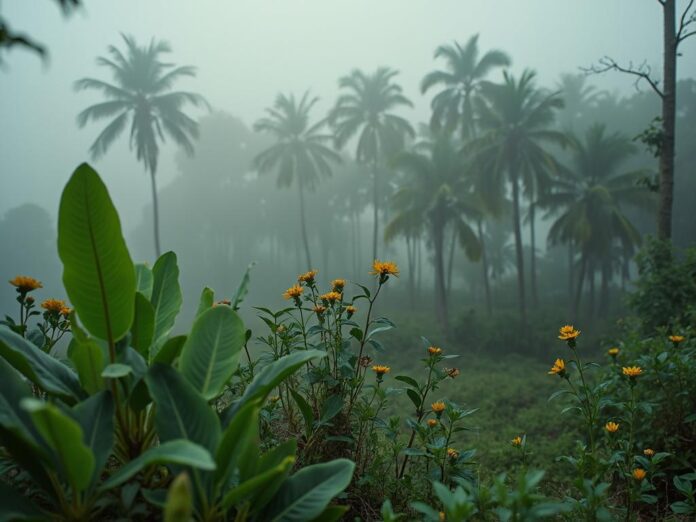Introduction
The San Martín Amazon Forest Restoration Campaign, launched in late October 2025 by regional authorities, aims to rehabilitate fire-damaged ecosystems in Peru’s biodiverse San Martín region [9]. This initiative emerges against a backdrop of severe Amazon challenges, including a 2025 deforestation drop of 11% in Brazil’s Amazon, yet surging degradation from fires [G2]. In San Martín, historical losses from mining and agriculture have displaced communities, with experts noting that without addressing root causes, restoration risks becoming symbolic [G6]. The campaign integrates tech like AI satellite monitoring and emphasizes indigenous knowledge, building on projects protecting 300,000 hectares of primary forest [2]. However, critiques from indigenous groups and analysts highlight potential greenwashing, where efforts offset damage without halting exploitation [G10]. This section overviews the campaign’s scope, blending factual progress with emerging debates on its authenticity.
Background and Key Initiatives
San Martín’s restoration efforts build on established projects, such as the 2017–2018 agroforestry initiative that planted 83,042 trees across 83 hectares in Tarapoto, partnering Reforest’Action with the Urku Center [1]. These systems deliver multifaceted benefits, including enhanced biodiversity, soil health, and socio-economic gains like income and education for locals [1]. Larger endeavors, like the Biocorredor Martin Sagrado, safeguard 300,000 hectares of rainforest through PUR collaborations [2], while the Alto Mayo Project preserves 182,000 hectares via community engagement with Conservation International and the Arbor Day Foundation, curbing deforestation rates [5].
Recent news underscores the 2025 campaign’s focus on post-fire recovery, with drone technology deploying seed spheres to regenerate landscapes [9] [G2]. Peru’s Second National Convention for Regional Conservation Areas in August 2025 stressed interregional coordination and indigenous integration, introducing AI for land monitoring [3]. Yet, studies warn that without quantifying net deforestation impacts, such as through GIS storymaps promoting sustainable agriculture [6], progress remains opaque [7]. TechnoServe’s 2025 analysis advocates multi-stakeholder partnerships and land reform to avoid top-down pitfalls [7] [G11].
Funding and Exploitation Concerns
Funding sources mix government support from IIAP and Minam with international aid, but opacity raises greenwashing fears [G1] [G10]. Critics point to ties with entities historically linked to palm oil and mining, where carbon credits in projects like Cordillera Azul have been accused of inflating baselines to mask ongoing harm [G10]. In San Martín, this could enable “restoration washing,” offsetting degradation elsewhere without tackling illegal logging [G3] [G8].
Balanced views note positive funding for job creation in agroforestry, fostering sustainable livelihoods [1] [G5] [G11]. However, dependency on foreign aid risks instability, as seen in past Amazon initiatives [G7]. Experts on social media express skepticism, linking U.S. investors to deforestation while praising community models that reduce corruption [G15] [G16]. A constructive path involves transparent, indigenous-led funding to prevent exploitation [3] [G3].
Indigenous Perspectives and Community Involvement
Indigenous voices are central yet conflicted. The Shawi Nation opposes a proposed highway slicing through 5,400 hectares of ancestral lands, risking invasion, mining, and coca expansion—only 160 of 514 communities have titles [4]. This highlights tenure insecurities undermining restoration [4] [7] [G9].
Positively, the campaign promotes community participation and traditional knowledge, aligning with the 2025 RCA Convention’s emphasis on equity [3]. Successful models, like community forestry reducing forest loss by 52% in monitored villages [G3], show empowerment potential. X sentiment reflects optimism for joint efforts conserving millions of hectares but warns of top-down approaches ignoring disputes [G17] [G18]. Solutions include prioritizing land titling and integrating Shawi practices into drone seeding [3] [4] [G2].
Ecological Impacts and Planting Practices
Ecologically, the campaign targets biodiversity via diverse planting, avoiding monocultures criticized in Amazon reforestation [G2] [G4] [G13]. Agroforestry in San Martín supports 293 plant species and wildlife resurgence, per similar Brazilian efforts [G18], while silvo-pastoral systems reduce forest-clearing pressure [7].
However, without addressing drivers like mining, restoration may perpetuate degradation cycles [G1] [G6]. Reports note unquantified net outcomes, with fires surging despite deforestation drops [G8]. Constructive alternatives emphasize natural regeneration and degrowth, scaling back industrial agriculture for true recovery [G6] [G13]. AI monitoring could enhance oversight, measuring water retention and species return [3] [G12].
Economic Aspects and Sustainability
Economically, initiatives like regenerative coffee projects create jobs and markets, boosting incomes via certification [7] [G11]. Yet, aid dependency critiques suggest short-term fixes over systemic change [G5] [G7].
Degrowth advocates propose phasing out high-impact farming for localized economies, integrating with restoration [G6]. X discussions celebrate reforestation livelihoods but urge challenging industrial dominance [G19] [G20]. Viable solutions include market incentives tied to biodiversity metrics [6] [7].
Key Figures
- Agroforestry planting in San Martín: 83,042 trees planted over 83 hectares in the Tarapoto area through a partnership between Reforest’Action and the Urku Center (2017–2018)[1].
- Conservation area: The Biocorredor Martin Sagrado project, supported by PUR, protects approximately 300,000 hectares of primary Amazonian rainforest in San Martín[2].
- Protected area under Alto Mayo Project: 182,000 hectares preserved in partnership with Conservation International and Arbor Day Foundation, focused on reducing deforestation through community engagement[5].
- Shawi territory at risk: A proposed highway would cut through 5,400 hectares of ancestral Shawi lands, threatening biodiversity and opening the area to further exploitation[4].
- Shawi land titling: Only 160 Shawi communities have received land titles; 514 are still seeking recognition[4].
Recent News
- 2025 San Martín Restoration Campaign: The San Martín regional government launched a 2025 campaign to restore landscapes damaged by forest fires, signaling ongoing commitment to ecological recovery[9].
- Indigenous opposition to infrastructure: In September 2025, the Shawi Nation publicly contested the Yurimaguas–Balsapuerto–Moyobamba highway, citing risks of land invasion, illegal mining, and coca cultivation expansion in their territory[4].
- Regional Conservation Convention: Peru’s Second National Convention for Regional Conservation Areas (August 2025) emphasized interregional coordination, gender equity, landscape connectivity, and integrating Indigenous knowledge into management—highlighting both progress and persistent challenges in conservation governance[3].
Studies and Reports
- Reforest’Action Agroforestry Project: Concludes that agroforestry systems in San Martín provide climate, biodiversity, water, soil, and socio-economic benefits, including income, education, and cultural empowerment for local communities[1].
- Alto Mayo Project Report: Highlights that community-based conservation has significantly reduced deforestation rates in the region, preserving rich flora and fauna[5].
- ArcGIS Storymap on San Martín: Documents the region’s transition toward sustainable agriculture and conservation, using GIS mapping to enhance transparency and market opportunities for producers. It notes policy evolution toward sustainable development but does not quantify net deforestation rates or ecological outcomes[6].
- TechnoServe Analysis (2025): Emphasizes that sustainable economic development in the Amazon requires multi-stakeholder partnerships, land tenure reform, and market-driven conservation incentives. It warns that without genuine community leadership and cross-sector collaboration, top-down approaches risk perpetuating dependency and marginalization[7].
Technological Developments
- Satellite Monitoring with AI: Recent conservation discussions highlight the use of satellite monitoring and artificial intelligence algorithms to enhance land oversight and management in regional conservation areas[3].
- GIS-Based Storymaps: The San Martín regional government employs interactive GIS storymaps to communicate conservation progress, supply chain transparency, and regional branding, serving as both accountability tools and marketing vehicles[6].
- Silvo-pastoral Systems: Transitioning cattle farms to silvo-pastoral systems is promoted as a way to raise productivity and reduce pressure to clear forests, supported by technical extension services and certification programs[7].
Regulations and Policies
- Regional Conservation Area (RCA) Network: Established in 2024 to strengthen coordination, harmonize policies, and dismantle administrative obstacles for conservation area management across Peru[3].
- Commitment to Indigenous Knowledge: The 2025 RCA Convention underscored the need to integrate traditional knowledge and ensure Indigenous participation in decision-making[3].
- Land Titling Challenges: Despite policy rhetoric, many Indigenous communities (e.g., Shawi) still lack formal land titles, leaving them vulnerable to exploitation and infrastructure projects[4].
- Sustainable Value Chains: Government and NGO efforts aim to promote sustainable agricultural products (e.g., coffee, cacao) through certification and market incentives, though impacts on deforestation rates are not fully quantified[7].
Ongoing Projects and Initiatives
- Reforest’Action/Urku Center Agroforestry: Active tree planting and agroforestry development in multiple San Martín localities[1].
- Biocorredor Martin Sagrado: Large-scale rainforest conservation in partnership with PUR and local organizations[2].
- Alto Mayo Protected Forest: Community-based forest protection and sustainable livelihood initiatives[5].
- Cordillera Escalera Restoration: Reforestation efforts in a designated conservation area[8].
- TechnoServe/JDE Peet’s Regenerative Coffee Initiative: Aims to strengthen sustainable coffee production in San Martín and other regions[7].
MAIN SOURCES:
- Reforest’Action – Tarapoto, Peru: Details a specific agroforestry project’s scope, benefits, and alignment with SDGs https://www.reforestaction.com/en/projects/2381 [1].
- PUR – Biocorredor Martin Sagrado: Describes a decade-long, large-scale rainforest conservation initiative https://www.pur.co/project/biocorredor-martin-sagrado-peru/ [2].
- Andes Amazon Fund – RCA Convention 2025: Reports on recent policy developments, interregional coordination, and Indigenous integration in conservation https://www.andesamazonfund.org/news-blog/forging-a-new-path-for-perus-regional-conservation-areas-from-cajamarca-to-cusco/ [3].
- Mongabay – Shawi Highway Conflict: Covers Indigenous opposition to infrastructure projects and land tenure issues https://news.mongabay.com/2025/10/new-road-in-peruvian-amazon-sparks-fear-of-invasion-among-indigenous-shawi/ [4].
- Arbor Day Foundation – Alto Mayo Project: Summarizes community-based conservation outcomes https://www.arborday.org/carbon/projects/alto-mayo [5].
- GCF Task Force – San Martín Storymap: Presents an interactive, GIS-based narrative of the region’s conservation and agricultural transformation https://www.gcftaskforceimpactinvesting.org/san-martin-peru/ [6].
- TechnoServe – Economic Development in the Amazon: Analyzes multi-stakeholder approaches, land tenure, and market-based conservation https://www.technoserve.org/blog/economic-development-in-the-amazon/ [7].
- Woodchuck USA – Cordillera Escalera: Overview of a reforestation project in a protected area https://www.woodchuckusa.com/pages/san-martin-peru [8].
—
Critical Synthesis
The San Martín Amazon Forest Restoration Campaign encompasses a mix of genuine ecological restoration, community engagement, and large-scale conservation, but also faces significant challenges and contradictions. Positive indicators include the planting of tens of thousands of trees[1], protection of hundreds of thousands of hectares of primary forest[2][5], adoption of satellite and AI monitoring[3], and policy moves toward integrating Indigenous knowledge[3]. Economic benefits are reported, especially where market-driven sustainable agriculture is promoted[7].
However, serious concerns remain: Indigenous communities like the Shawi face ongoing land tenure insecurity and threats from infrastructure projects backed by authorities[4]. While some projects emphasize community participation, there is evidence that top-down approaches and dependency on foreign aid persist[7]. The lack of comprehensive, independent data on net deforestation rates, biodiversity recovery, and long-term socio-economic impacts makes it difficult to assess whether the campaign is achieving systemic change or merely offsetting ongoing damage elsewhere.
Technological and policy innovations (GIS, AI, RCA Network) are promising but not yet proven at scale[3][6]. Degrowth or scaling back industrial agriculture is not a prominent part of current policy debates; instead, the focus is on “sustainable intensification” and market-based solutions[7]. Monoculture vs. biodiversity is not directly addressed in available reports, though agroforestry projects claim multi-species planting[1].
In summary: The San Martín campaign demonstrates real, measurable efforts in restoration and conservation, with some tangible benefits for ecosystems and communities. Yet, structural issues—land rights, infrastructure pressures, and the risk of greenwashing by offsetting rather than halting deforestation—mean it cannot yet be considered a fully genuine, systemic solution. Continued scrutiny, independent monitoring, and deeper integration of Indigenous leadership and degrowth principles are essential for the campaign to fulfill its promise.


